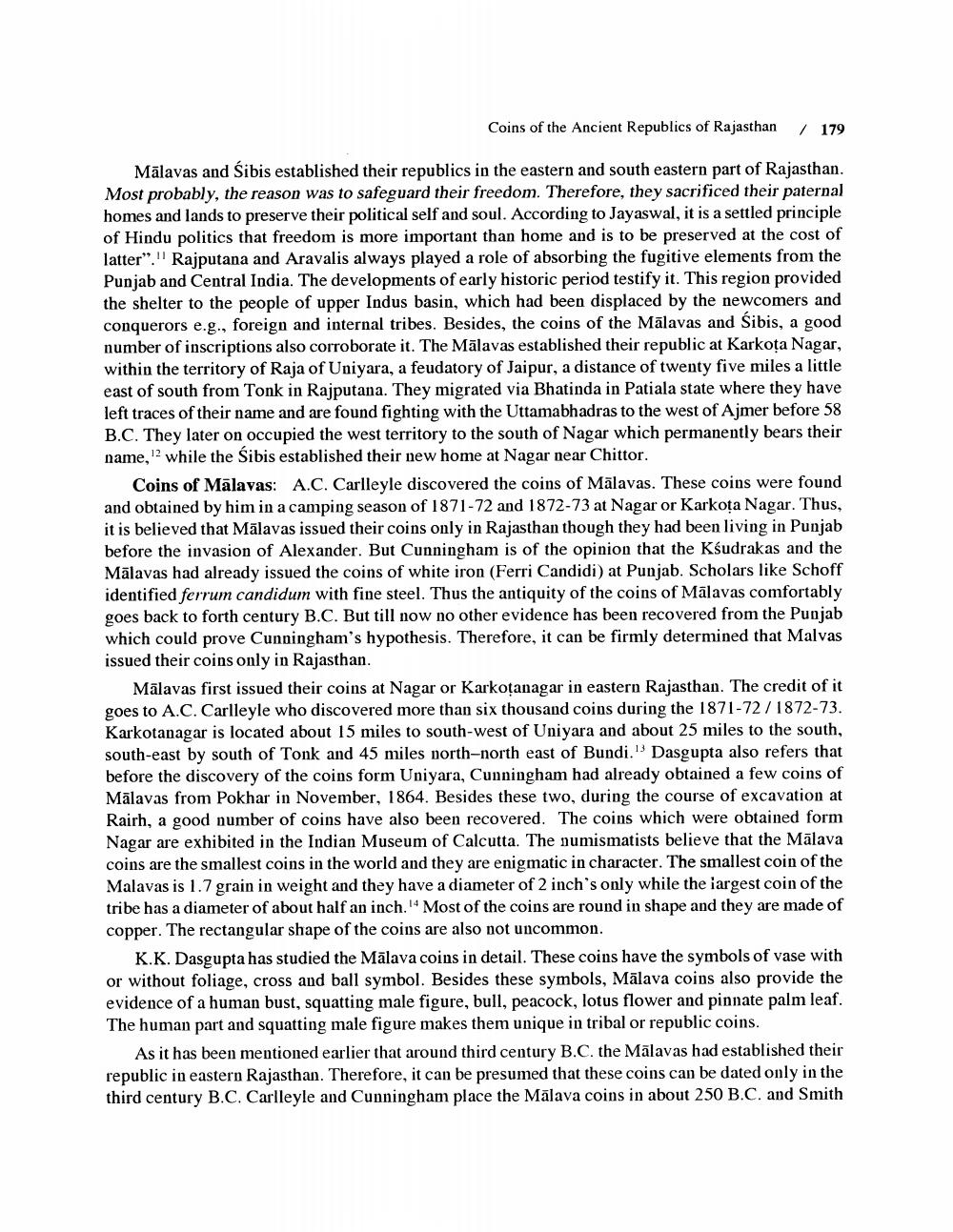________________
Coins of the Ancient Republics of Rajasthan
/ 179
Mālavas and Sibis established their republics in the eastern and south eastern part of Rajasthan. Most probably, the reason was to safeguard their freedom. Therefore, they sacrificed their paternal homes and lands to preserve their political self and soul. According to Jayaswal, it is a settled principle of Hindu politics that freedom is more important than home and is to be preserved at the cost of latter"." Rajputana and Aravalis always played a role of absorbing the fugitive elements from the Punjab and Central India. The developments of early historic period testify it. This region provided the shelter to the people of upper Indus basin, which had been displaced by the newcomers and conquerors e.g., foreign and internal tribes. Besides, the coins of the Mālavas and Sibis, a good number of inscriptions also corroborate it. The Mālavas established their republic at Karkota Nagar, within the territory of Raja of Uniyara, a feudatory of Jaipur, a distance of twenty five miles a little east of south from Tonk in Rajputana. They migrated via Bhatinda in Patiala state where they have left traces of their name and are found fighting with the Uttamabhadras to the west of Ajmer before 58 B.C. They later on occupied the west territory to the south of Nagar which permanently bears their name, while the Sibis established their new home at Nagar near Chittor.
Coins of Mālavas: A.C. Carlleyle discovered the coins of Mālavas. These coins were found and obtained by him in a camping season of 1871-72 and 1872-73 at Nagar or Karkoța Nagar. Thus, it is believed that Mālavas issued their coins only in Rajasthan though they had been living in Punjab before the invasion of Alexander. But Cunningham is of the opinion that the Kśudrakas and the Mālavas had already issued the coins of white iron (Ferri Candidi) at Punjab. Scholars like Schoff identified ferrum candidum with fine steel. Thus the antiquity of the coins of Mālavas comfortably goes back to forth century B.C. But till now no other evidence has been recovered from the Punjab which could prove Cunningham's hypothesis. Therefore, it can be firmly determined that Malvas issued their coins only in Rajasthan.
Mālavas first issued their coins at Nagar or Karkotanagar in eastern Rajasthan. The credit of it goes to A.C. Carlleyle who discovered more than six thousand coins during the 1871-72 / 1872-73. Karkotanagar is located about 15 miles to south-west of Uniyara and about 25 miles to the south, south-east by south of Tonk and 45 miles north-north east of Bundi." Dasgupta also refers that before the discovery of the coins form Uniyara, Cunningham had already obtained a few coins of Mālavas from Pokhar in November, 1864. Besides these two, during the course of excavation at Rairh, a good number of coins have also been recovered. The coins which were obtained form Nagar are exhibited in the Indian Museum of Calcutta. The numismatists believe that the Mālava coins are the smallest coins in the world and they are enigmatic in character. The smallest coin of the Malavas is 1.7 grain in weight and they have a diameter of 2 inch's only while the largest coin of the tribe has a diameter of about half an inch. Most of the coins are round in shape and they are made of copper. The rectangular shape of the coins are also not uncommon.
K.K. Dasgupta has studied the Mālava coins in detail. These coins have the symbols of vase with or without foliage, cross and ball symbol. Besides these symbols, Mālava coins also provide the evidence of a human bust, squatting male figure, bull, peacock, lotus flower and pinnate palm leaf. The human part and squatting male figure makes them unique in tribal or republic coins.
As it has been mentioned earlier that around third century B.C. the Mālavas had established their republic in eastern Rajasthan. Therefore, it can be presumed that these coins can be dated only in the third century B.C. Carlleyle and Cunningham place the Mālava coins in about 250 B.C. and Smith




